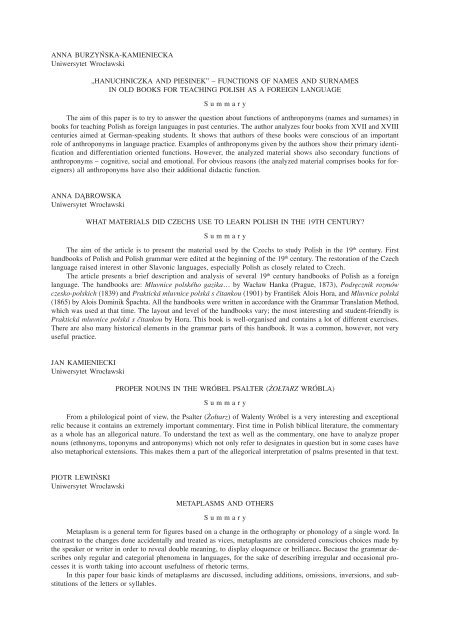ROZPRAWY KOMISJI JĘZYKOWEJ XXXVII
ROZPRAWY KOMISJI JĘZYKOWEJ XXXVII
ROZPRAWY KOMISJI JĘZYKOWEJ XXXVII
You also want an ePaper? Increase the reach of your titles
YUMPU automatically turns print PDFs into web optimized ePapers that Google loves.
ANNA BURZYÑSKA-KAMIENIECKA<br />
Uniwersytet Wroc³awski<br />
„HANUCHNICZKA AND PIESINEK” – FUNCTIONS OF NAMES AND SURNAMES<br />
IN OLD BOOKS FOR TEACHING POLISH AS A FOREIGN LANGUAGE<br />
S u m m a r y<br />
The aim of this paper is to try to answer the question about functions of anthroponyms (names and surnames) in<br />
books for teaching Polish as foreign languages in past centuries. The author analyzes four books from XVII and XVIII<br />
centuries aimed at German-speaking students. It shows that authors of these books were conscious of an important<br />
role of anthroponyms in language practice. Examples of anthroponyms given by the authors show their primary identification<br />
and differentiation oriented functions. However, the analyzed material shows also secondary functions of<br />
anthroponyms – cognitive, social and emotional. For obvious reasons (the analyzed material comprises books for foreigners)<br />
all anthroponyms have also their additional didactic function.<br />
ANNA D¥BROWSKA<br />
Uniwersytet Wroc³awski<br />
WHAT MATERIALS DID CZECHS USE TO LEARN POLISH IN THE 19TH CENTURY?<br />
S u m m a r y<br />
The aim of the article is to present the material used by the Czechs to study Polish in the 19th century. First<br />
handbooks of Polish and Polish grammar were edited at the beginning of the 19th century. The restoration of the Czech<br />
language raised interest in other Slavonic languages, especially Polish as closely related to Czech.<br />
The article presents a brief description and analysis of several 19th century handbooks of Polish as a foreign<br />
language. The handbooks are: Mluvnice polského gazika… by Wac³aw Hanka (Prague, 1873), Podrêcznik rozmów<br />
czesko-polskich (1839) and Praktická mluvnice polská s èitankou (1901) by František Alois Hora, and Mluvnice polská<br />
(1865) by Alois Dominik Špachta. All the handbooks were written in accordance with the Grammar Translation Method,<br />
which was used at that time. The layout and level of the handbooks vary; the most interesting and student-friendly is<br />
Praktická mluvnice polská s èitankou by Hora. This book is well-organised and contains a lot of different exercises.<br />
There are also many historical elements in the grammar parts of this handbook. It was a common, however, not very<br />
useful practice.<br />
JAN KAMIENIECKI<br />
Uniwersytet Wroc³awski<br />
PROPER NOUNS IN THE WRÓBEL PSALTER (¯O£TARZ WRÓBLA)<br />
S u m m a r y<br />
From a philological point of view, the Psalter (¯o³tarz) of Walenty Wróbel is a very interesting and exceptional<br />
relic because it contains an extremely important commentary. First time in Polish biblical literature, the commentary<br />
as a whole has an allegorical nature. To understand the text as well as the commentary, one have to analyze proper<br />
nouns (ethnonyms, toponyms and antroponyms) which not only refer to designates in question but in some cases have<br />
also metaphorical extensions. This makes them a part of the allegorical interpretation of psalms presented in that text.<br />
PIOTR LEWIÑSKI<br />
Uniwersytet Wroc³awski<br />
METAPLASMS AND OTHERS<br />
S u m m a r y<br />
Metaplasm is a general term for figures based on a change in the orthography or phonology of a single word. In<br />
contrast to the changes done accidentally and treated as vices, metaplasms are considered conscious choices made by<br />
the speaker or writer in order to reveal double meaning, to display eloquence or brilliance. Because the grammar describes<br />
only regular and categorial phenomena in languages, for the sake of describing irregular and occasional processes<br />
it is worth taking into account usefulness of rhetoric terms.<br />
In this paper four basic kinds of metaplasms are discussed, including additions, omissions, inversions, and substitutions<br />
of the letters or syllables.


